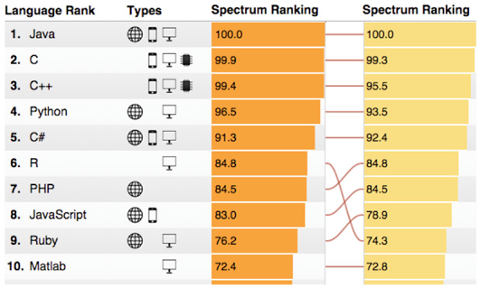 Although top programming languages such as Java, C, Python and PHP remain widely used, their collective market-share has fallen in recent years, according to the latest TIOBE Index. “The set of languages to choose from is getting bigger and more and more less well-known programming languages are being adopted,” read the note accompanying this month’s Index. “About 10 years ago, the first 8 languages covered 80 percent of the market, now this is reduced to 55 percent.” For the record, those eight languages are (in descending order) Java, C, C++, Python, C#, PHP, JavaScript, and Perl. TIOBE relies on search-engine data to calculate its ratings, in contrast to other indexes that depend on datasets from GitHub and other repositories. Languages in its top quadrant have a tendency to stay in place; Java, C, and C++, for example, have remained in the first three slots (respectively) since at least June 2015. But further down TIOBE’s list, new and obscure languages are making headway. Swift, Apple’s next-generation language for building iOS and Mac OS X apps, is busy cannibalizing market-share for its predecessor, Objective-C. Ruby, D, and Assembly Language have also enjoyed significant gains over the past 12 months. Even if these smaller languages are seizing more market-share, however, the languages at the top of the list remain virtually ubiquitous, and it seems unlikely that any will tumble into obscurity anytime soon. If you’re still learning Java, for example, rest assured it will continue to power many platforms for quite some time to come.
Although top programming languages such as Java, C, Python and PHP remain widely used, their collective market-share has fallen in recent years, according to the latest TIOBE Index. “The set of languages to choose from is getting bigger and more and more less well-known programming languages are being adopted,” read the note accompanying this month’s Index. “About 10 years ago, the first 8 languages covered 80 percent of the market, now this is reduced to 55 percent.” For the record, those eight languages are (in descending order) Java, C, C++, Python, C#, PHP, JavaScript, and Perl. TIOBE relies on search-engine data to calculate its ratings, in contrast to other indexes that depend on datasets from GitHub and other repositories. Languages in its top quadrant have a tendency to stay in place; Java, C, and C++, for example, have remained in the first three slots (respectively) since at least June 2015. But further down TIOBE’s list, new and obscure languages are making headway. Swift, Apple’s next-generation language for building iOS and Mac OS X apps, is busy cannibalizing market-share for its predecessor, Objective-C. Ruby, D, and Assembly Language have also enjoyed significant gains over the past 12 months. Even if these smaller languages are seizing more market-share, however, the languages at the top of the list remain virtually ubiquitous, and it seems unlikely that any will tumble into obscurity anytime soon. If you’re still learning Java, for example, rest assured it will continue to power many platforms for quite some time to come. Top Programming Languages Losing Market Share?
 Although top programming languages such as Java, C, Python and PHP remain widely used, their collective market-share has fallen in recent years, according to the latest TIOBE Index. “The set of languages to choose from is getting bigger and more and more less well-known programming languages are being adopted,” read the note accompanying this month’s Index. “About 10 years ago, the first 8 languages covered 80 percent of the market, now this is reduced to 55 percent.” For the record, those eight languages are (in descending order) Java, C, C++, Python, C#, PHP, JavaScript, and Perl. TIOBE relies on search-engine data to calculate its ratings, in contrast to other indexes that depend on datasets from GitHub and other repositories. Languages in its top quadrant have a tendency to stay in place; Java, C, and C++, for example, have remained in the first three slots (respectively) since at least June 2015. But further down TIOBE’s list, new and obscure languages are making headway. Swift, Apple’s next-generation language for building iOS and Mac OS X apps, is busy cannibalizing market-share for its predecessor, Objective-C. Ruby, D, and Assembly Language have also enjoyed significant gains over the past 12 months. Even if these smaller languages are seizing more market-share, however, the languages at the top of the list remain virtually ubiquitous, and it seems unlikely that any will tumble into obscurity anytime soon. If you’re still learning Java, for example, rest assured it will continue to power many platforms for quite some time to come.
Although top programming languages such as Java, C, Python and PHP remain widely used, their collective market-share has fallen in recent years, according to the latest TIOBE Index. “The set of languages to choose from is getting bigger and more and more less well-known programming languages are being adopted,” read the note accompanying this month’s Index. “About 10 years ago, the first 8 languages covered 80 percent of the market, now this is reduced to 55 percent.” For the record, those eight languages are (in descending order) Java, C, C++, Python, C#, PHP, JavaScript, and Perl. TIOBE relies on search-engine data to calculate its ratings, in contrast to other indexes that depend on datasets from GitHub and other repositories. Languages in its top quadrant have a tendency to stay in place; Java, C, and C++, for example, have remained in the first three slots (respectively) since at least June 2015. But further down TIOBE’s list, new and obscure languages are making headway. Swift, Apple’s next-generation language for building iOS and Mac OS X apps, is busy cannibalizing market-share for its predecessor, Objective-C. Ruby, D, and Assembly Language have also enjoyed significant gains over the past 12 months. Even if these smaller languages are seizing more market-share, however, the languages at the top of the list remain virtually ubiquitous, and it seems unlikely that any will tumble into obscurity anytime soon. If you’re still learning Java, for example, rest assured it will continue to power many platforms for quite some time to come. 


